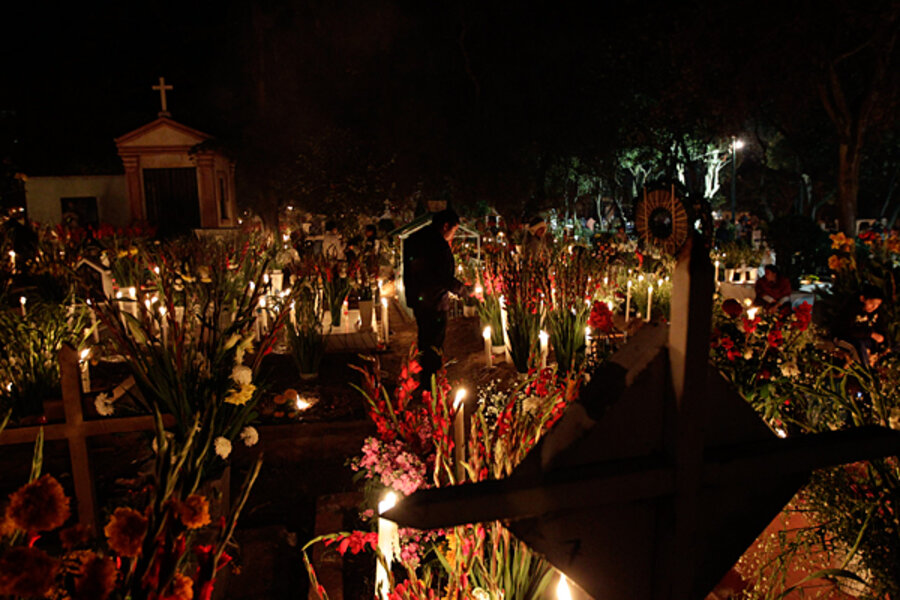Day of the Dead takes on new meaning for families of Mexico's disappeared
Loading...
Maria Elena Salazar refuses to set out plates of her missing son's favorite foods or orange flowers as offerings for the deceased on Mexico's Day of the Dead, even though she hasn't seen him in three-and-a-half years.
The 50-year-old former teacher is convinced that Hugo Gonzalez Salazar, a university graduate in marketing who worked for a telephone company, is still alive and being forced to work for a drug cartel because of his skills.
"The government, the authorities, they know it, that the gangs took them away to use as forced labor," said Salazar of her then 24-year-old son, who disappeared in the northern city of Torreon in July 2009.
The Day of the Dead – when Mexicans traditionally visit the graves of dead relatives and leave offerings of flowers, food and candy skulls – is a difficult time for the families of the thousands of Mexicans who have disappeared amid a wave of drug-fueled violence.
With what activists call a mix of denial, hope and desperation, they refuse to dedicate altars on the Nov. 1-2 holiday to people often missing for years. They won't accept any but the most certain proof of death, and sometimes reject even that.
Numbers vary on just how many people have disappeared in recent years. Mexico's National Human Rights Commission says 24,000 people have been reported missing between 2000 and mid-2012, and that nearly 16,000 bodies remain unidentified.
But one thing is clear: just as there are households without Day of the Dead altars, there are thousands of graves of the unidentified dead scattered across the country, with no one to remember them.
An investigation conducted by the newspaper Milenio this week, involving hundreds of information requests to state and municipal governments, indicates that 24,102 unidentified bodies were buried in paupers' or common graves in Mexican cemeteries since 2006. The number is almost certainly incomplete, since some local governments refused to provide figures, Milenio reported.
And while the number of unidentified dead probably includes some indigents, Central American migrants or dead unrelated to the drug war, it is clear that cities worst hit by the drug conflict also usually showed a corresponding bulge in the number of unidentified cadavers. For example, Mexico City, which has been relatively unscathed by drug violence, listed about one-third as many unidentified burials as the city of Veracruz, despite the fact that Mexico City's population is about 15 times larger.
Consuelo Morales , who works with dozens of families of disappeared in the northern city of Monterrey, said that "holidays like this, that are family affairs and are very close to our culture, stir a lot of things up" for the families. But many refuse to accept the deaths of their loved ones, sometimes even after DNA testing confirms a match with a cadaver.
"They'll say to you, 'I'm not going to put up an altar, because they're not dead," Martinez noted. "Their thinking is that 'until they prove to me that my child is dead, he is alive."
Martinez says one family she works with at the Citizens in Support of Human Rights center had refused to accept their son was dead, even after three rounds of DNA testing and the exhumation of the remains.
"It was their son, he was very young, and he had been burned alive," Martinez said by way of explanation.
The refusal to accept what appears inevitable may be a matter of desperation. Martinez said some families in Monterrey also believe their missing relatives are being held as virtual slaves for the cartels, even though federal prosecutors say they have never uncovered any kind of drug cartel forced-labor camp, in the six years since Mexico launched an offensive against the cartels.
But many people like Salazar believe it must be true. "Organized crime is a business, but it can't advertise for employees openly, so it has to take them by force," Salazar said.
While she refuses to erect an altar-like offering for her son, she does perform other rituals that mirror the Day of the Dead customs, like the one that involves scattering a trail of flower petals to the doorsteps of houses to guide spirits of the departed back home once a year.
Salazar and her family still live in the same home in Torreon, though they'd like to move, in the hopes that Hugo will return there. They pray three times a day for God to guide him home.
"We live in the same place, and we try to do the same things we used to," said Salazar, "because he is going to come back to his place, his home, and we have to be waiting for him."
Mistrust of officials has risen to such a point that some families may never get an answer they'll accept.
The problem is that, with forensics procedures often sadly lacking in Mexican police forces, the dead my never be connected with the living, which is the whole point of the Mexican traditions.
"As long as the authorities don't prove the opposite, for us they're still alive," Salazar said. "Let them prove it, but let us have some certainty, not just the authorities saying 'here he is.' We don't the government to just give us bodies that aren't theirs, and that has happened."







